Integrating human and machine intelligence
The traditional models of corporate innovation, driven by collective creativity, have long been the cornerstone of progress. New innovations, from incremental modifications to radical transformations, are made better, more robust through the power of collaboration, diverse perspectives, and expertise. These days, though, corporate innovators are increasingly confronted with the inherent limitations of approaches that rely solely on the “wisdom of the crowd.” Due to those limitations, many companies struggle to see the actual business impact of their various innovation activities—despite ever-increasing corporate innovation spending.
The good news is that at this very moment, we find ourselves on the cusp of a technological revolution: the accelerating adoption of artificial intelligence (AI) across industries. Blending machine intelligence and human ingenuity has the potential to overcome the major sticking points of corporate innovation and unlock previously unimagined levels of productivity.
This guide will delve into the forces shaping the future of innovation and why a shift in how companies innovate is imperative. We outline our vision for the future of innovation, in which humans and technology combine to complement and magnify each other in a single Innovation Operation System (Innovation OS)—a company-wide platform for end-to-end innovation designed to connect the dots from strategy to execution. Finally, we discuss the implications for corporate innovation and how ITONICS makes innovation not only more accessible, collaborative, and inspiring but also smarter, faster, and more transformative.
Forces shaping the future of innovation
What challenges do corporate innovation departments currently face?
Rising volatility and uncertainty
The pace of change and technology is accelerating. Volatility and uncertainty are rising. Markets are increasingly globalized, commoditized, and regulated. And both customers and competition are constantly evolving.
These forces are felt acutely by companies across industries and geographies. Two out of five global CEOs believe their organization will fail to remain economically viable in the next decade if business as usual is maintained.
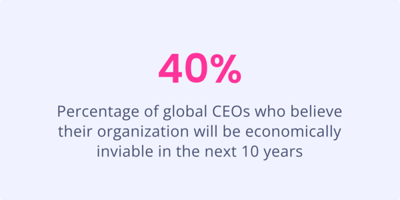
The need to innovate, to keep pace with or try to preempt these forces of change, is well understood. Executives are investing millions in lean strategies, emerging technology, and tools to improve efficiency, business intelligence, and project management. And yet, many of these efforts fail to produce the breakthroughs needed to stay ahead of the competition.
Diminishing returns on innovation spending
Driven by an innovation imperative, organizations globally have steadily increased their innovation investment over the past 15 years. Across industries, innovation has seized larger and larger shares of the company budget; for instance, R&D spending today has surpassed advertising spending by a factor of ten (from about equal budget size 40 years ago).
However, many companies do not see the tangible results they expect from this spending. On the contrary: across industries, analysts report a significant decline in the productivity of corporate innovation efforts, turning innovation spending more and more into a black box. Over the past five years in the United States alone, innovation investments have underperformed to the tune of $1 trillion.
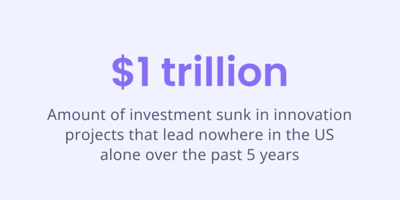
Companies face many internal obstacles in trying to maximize their return on innovation investment. But most of these can be summed up in three prevailing themes: lack of long-term perspective, lack of focus, and lack of oversight.
The three biggest obstacles to corporate innovation
1. Lack of long-term perspective
An overwhelming majority of CEOs are pessimistic about future global economic growth. And so, despite acknowledging the imperative for change, many companies will figuratively bunker down, fortify business as usual, and protect existing products, customers, and cash flow when faced with this economic uncertainty. They will prioritize short-term gains to the detriment of long-term planning.
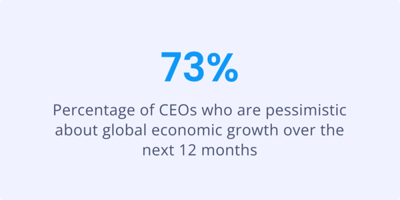
The consequence of this risk aversion is a lack of balance in many companies' innovation portfolios. This imbalance often manifests as an overemphasis on pursuing "low-hanging fruit" and incremental innovations in Horizon 1. In turn, companies can lose sight of the big picture, narrowing their innovation pipeline and missing out on promising opportunities. By underinvesting in innovation across Horizons 2 and 3, companies are more likely to expose themselves to disruption from competitors and obsolescence in the minds of customers down the road (see the 70:20:10 rule of innovation).
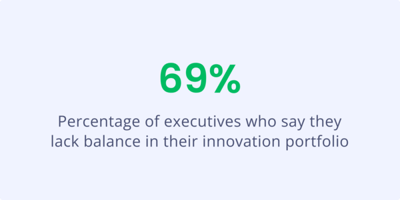
On the other hand, companies that invest wisely in innovation during economic uncertainty are well-positioned to capitalize on emerging opportunities and secure sustainable success, experiencing, on average, 2.4 times higher profit than their competitors. This correlation hinges on a company’s ability to prevent quick wins from obscuring future ambition.
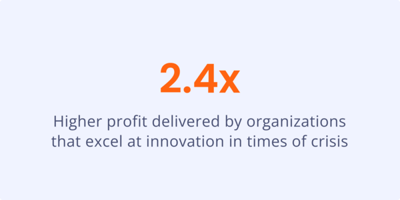
Companies that build agile innovation portfolios, balancing ambitions across the three horizons, are shown to outperform competitors and have a better price-to-earnings ratio. Maintaining this balance—monitoring and adapting initiatives accordingly—is one of the most important responsibilities innovation portfolio managers must perform. It is essential to fostering future readiness in times of crisis, disruption, and uncertainty.
2. Lack of focus
Resource allocation is critical to successful corporate innovation. Resources are finite, so organizations must set a strong strategic focus to ensure their most promising innovation initiatives receive adequate support. In many cases, this simply does not happen. Consequently, only 11% of executives report that their company’s strategic priorities have the necessary resources to succeed.
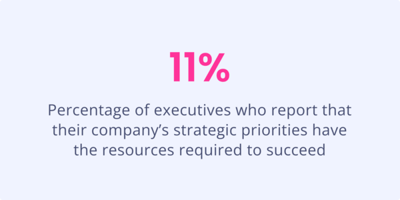
Unfortunately, prevailing investments into collective creativity have intensified the problem. Well-intentioned initiatives to make innovation more inclusive and activate diverse expertise from both inside and outside a firm have produced a flood of ideas and inflated the volume of innovation portfolios. As a result, weak ideas and “zombie projects” often receive funding and risk cannibalizing the innovation initiatives that matter the most. Nearly two-thirds of business leaders claim their organizations expend high-value resources on low-value endeavors. Meanwhile, smaller firms with modest yet smarter allocation of R&D budgets see a higher return on sales.
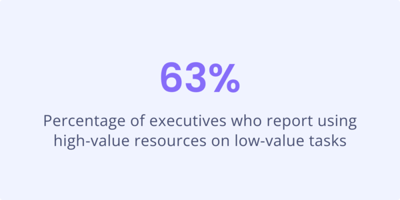
Matching resources with strategic priorities is often impeded by an inability to make quick and effective decisions. Gathering evidence to support long-term impact predictions, let alone securing stakeholder buy-in, can be extremely challenging, especially when trying to anticipate the effects of initiatives five to ten years into the future.
Allocating a finite amount of resources—be it money, time, expertise, or labor—to new innovations requires empowered decision-making. And this doesn’t happen in a vacuum. Companies that make strategic decisions quickly and successfully do so within a framework that is structured yet agile, integrating data-driven insights, cross-functional collaboration, and continuous evaluation.
3. Lack of oversight
Ultimately, one of the biggest obstacles to corporate innovation is the lack of end-to-end innovation governance and robust oversight of ongoing efforts. Fragmented workflows across the innovation value chain create challenges in engaging people and fostering collaboration. Misalignment between teams that use multiple tools creates information silos, duplication of efforts, and missed opportunities.
If all that innovation entailed was a great strategy and the collection of bright ideas, there may be little need for an end-to-end perspective. But strategies and ideas are intangible, tenuous things, and their potential value is only unlocked through alignment and smart execution. Companies without robust oversight of innovation’s many moving parts often struggle to anticipate potential synergies and roadblocks early on.
Even amongst well-formulated innovation strategies, there is a failure rate of 67%. What’s more, of the nearly 30,000 new products launched each year, 95% fail, chiefly because of opaque decision-making that has not properly considered market forces.
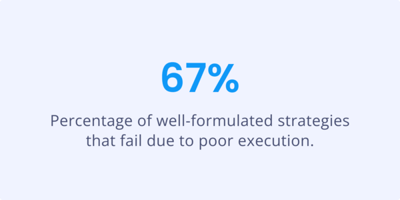
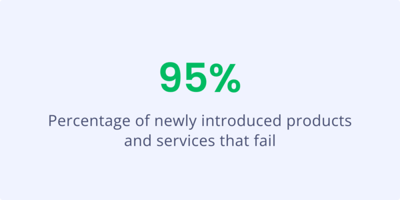
To put it simply, many companies fail to identify key interdependencies and connect the dots from strategy to execution. And it’s this inability to connect the dots, borne out of a lack of transparency and oversight, that dooms the majority of ideas before they’ve even left the drawing board.
Transforming innovation through augmented intelligence
In summary, here’s what we know about the future of innovation:
- Volatility and uncertainty in the world will rise.
- The imperative to innovate—to adapt, remain relevant with customers, and to do so faster and better than the competition—will grow.
- Many organizations that invest in innovation will face internal obstacles that diminish their ROI.
Point three, however, is not a foregone conclusion. We’re experiencing a shift from traditional and fragmented models of managing innovation—where these obstacles prevail—to a more effective model: continuous end-to-end innovation managed in one centralized operating system.
And here’s what else we know about the future: machine intelligence is driving unprecedented efficiencies, giving rise to previously unimaginable opportunities, and transforming the way we live, work, and innovate. That’s why the ITONICS Innovation OS seamlessly combines machine intelligence and human ingenuity.
The future of innovation will see augmented intelligence seamlessly integrated into the core of decision-making processes, radically upgrading our capabilities for creation, collaboration, and groundbreaking innovation.
A snapshot of the future of innovation
What does the future look like as we replace traditional ways of innovating with a smarter, faster, and more impactful approach?
We are decisively entering the age of augmented intelligence.
Machine learning and artificial intelligence have impacted nearly all industries, completely changing how we process and make sense of data. These technologies enable us to derive patterns, perform diagnostics, and make predictions with increasing accuracy, speed, and scale.
We interact with these capabilities daily, often running in the background, powering the apps and tools we use for everything from monitoring our health and finances to making work more productive and collaborative.
Why should innovation be any different?
As machine learning becomes ubiquitous and the need to innovate crystallizes in the corporate agendas of many companies, there is a tectonic shift occurring in how we innovate.
ITONICS believes that the future of innovating will leverage machine intelligence as a multiplier to human ingenuity. This marks a shift away from siloed idea funnels towards automated systems that connect the dots, identify gaps, and develop opportunities—systematically and continuously.
Why work harder when you can innovate smarter?
From sporadic to continuous innovation
Traditional approaches to innovation have often been project-based and performed in isolation from other projects, departments, and objectives in a business. Even when drawing on more open approaches to involve employees or external actors, such efforts too often take the form of once-off campaigns lacking clear follow-up plans. These efforts tend to be sporadic, and few business leaders are confident in their companies' ability to plan for the long term on a proactive and ongoing basis.
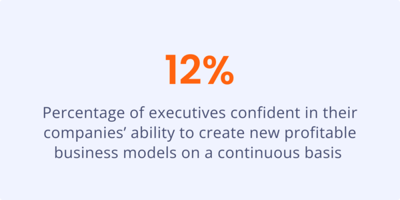
In contrast, continuous innovation is a sustainable approach by which organizations continually seek and implement new ideas, improvements, and changes in their products, processes, or strategies over time. By emphasizing an ongoing commitment to improvement over one-time breakthroughs, continuous innovation allows companies to adapt to rapidly changing environments and seize new opportunities.
An always-on Innovation Operating System
With ITONICS, innovation is no longer something you do as part of a specific project and then set aside. Experience shows us that innovation thrives when it is part of an organization’s DNA and addresses these three critical questions: where to play, how to win, and what to execute. We call this our Big Picture, the foundation of the Innovation OS, which seamlessly integrates your foresight and ideation activities with your innovation portfolios. Powered by machine intelligence—to amplify your collective creativity—ITONICS provides an always-on engine for collaborative, consistent, and continuous innovation.
From ideas-centric to execution-centric
Many organizations still place a heavy emphasis on generating ideas as the primary driver of innovation. The belief is that by brainstorming and collecting a multitude of creative ideas, innovation will naturally follow. But the innovation world is littered with examples of companies generating promising-on-paper and often parallel ideas—only to fail or succeed based on their execution.
Innovation requires more than just coming up with ideas. In fact, ideation may be the easiest part of the process, particularly when new platforms and tools make it easy for people to contribute.
There is a growing understanding that ideas alone do not lead to innovation; execution is essential. Shifting the focus to execution ensures that ideas are effectively translated into tangible results. The critical differentiators are in the what, when, and how of execution: what ideas, when to act, and how to allocate resources and commercialize.
Turning ideas into action
ITONICS Ideation mobilizes your end-to-end ideas ecosystem. It blends human and machine intelligence to generate and evaluate ideas quickly while streamlining execution and value realization. With smart phase-gate workflows, you can move ideas through the idea funnel, systematically checking off important tasks and milestones. Our configurable workflows allow you to define tasks, timeframes, and owners for each phase, guiding the process and reducing administrative effort. By establishing a clear and transparent process for developing, enriching, monitoring, and resourcing ideas, ITONICS Ideation turns your most promising ideas into market-ready innovations.
Learn how to set up an effective phase-gate process in ITONICS →
From siloed to centralized
It’s well recognized that collaboration and knowledge sharing foster more comprehensive and effective innovation. And yet, many companies still approach innovation as siloed teams with a fragmented set of tools—one platform for this department to collect ideas, a different tool for that unit to manage technologies—resulting in inefficient and opaque innovation ecosystems.
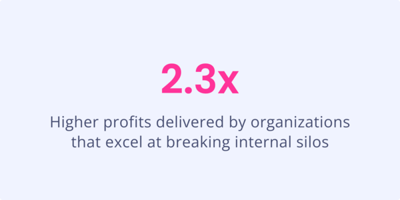
Centralizing end-to-end innovation intelligence is the single most important step companies can take to promote an innovation culture where all employees have access to the tools and information they need to participate in innovation. Breaking internal silos is about creating one transparent point of truth to reduce redundancy, save time and resources, and accelerate decision-making. In real terms, this translates to 2.3 times higher profit.
A 360-degree portfolio view
ITONICS Lists is a new tool that enables you to effortlessly oversee your entire innovation portfolio through a single, centralized view. Lists eliminates the need to switch between spreadsheets and various documents, empowering decision-makers to act with the speed and confidence that comes from data-driven insights. Monitor performance, budget, and KPIs in one central point of truth, in real-time, with this dynamic tool—equipped with interactive editing, filtering, and sorting.
From collecting to connecting
Many steps in innovation begin with information gathering: identifying signals and drivers of change, capturing new ideas, and collecting data on customers, competitors, and potential partners. But companies can easily fall into the trap of simply “piling the haystack”—collecting innovation-related information while failing to convert it into meaningful innovation intelligence.
Connecting dots [...] is how savvy executives are creating breakthrough products and other world-beating initiatives.
Building innovation intelligence requires organizations to move beyond collecting information. They must actively form connections, validate assumptions, and integrate organizational knowledge. Underpinning this process with machine intelligence allows organizations to derive more robust, evidence-based insights and solutions while steering strategic decision-making.
Smarter, faster sensemaking
ITONICS automates sensemaking to help you quickly connect the dots from strategy to execution. Our smart recommendations tool uses machine learning to automatically suggest relevant tags, related elements, and experts within your workspace. It instantly categorizes information, identifying interdependencies, synergies, and gaps in your innovation intelligence. Increase hit rates by connecting external drivers of change and internal capabilities to your innovation initiatives, removing bias and ambiguity from the decision-making process.
From manual to automated
Despite a steady increase in workplace productivity and a growing focus on automation tools and solutions, many knowledge workers remain overburdened with manual, time-consuming tasks. Two out of five innovation professionals report spending more time on documentation than on actual innovation. And it’s not only about speed and efficiency; manual processes are more likely to result in errors and missed opportunities.
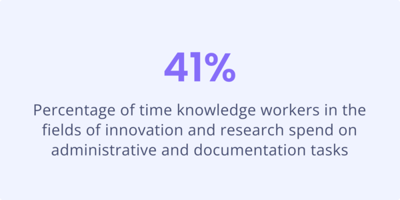
While automation is nothing new, its application in innovation is still underestimated and often misunderstood. With the ability to quickly identify patterns, trends, and connections amidst large datasets that may otherwise be indiscernible to humans, machine intelligence paves the way for data-driven innovation—performed at speed and scale. Automating various steps in the innovation process likewise frees human resources to focus on the more strategic aspects of innovation.
An automated early warning system
Powered by machine learning, ITONICS Automated Monitoring is a new tool that automates the tracking and monitoring of trends, technologies, startups, competitors, risks, and existing opportunities. It uses smart scoring to contextualize signals, cutting through the noise and making it easier to focus on what really matters. Automated Monitoring delivers real-time visualizations of changes in your business environment over time. It automatically sends alerts to your inbox to ensure you never miss an important development, whether sudden or sustained, allowing you to make more informed, proactive decisions.
Learn more about the new ITONICS Automated Monitoring tool →
From democratized to empowered
The concept of democratizing innovation has been around for decades. However, despite the fairly mature trend of open innovation, the prevalence of crowdsourcing platforms, and plenty of evidence validating the benefits of diverse perspectives in innovation, many organizational cultures, structures, and mechanisms fall short of achieving the full potential of inclusive innovation.
The biggest opportunities generative AI offers to businesses and governments is to augment human creativity and overcome the challenges of democratizing innovation.
Empowering everyone to innovate isn’t just about opening the floodgates. Empowered innovation guides participants with information and tools that adequately channel their creativity, reduce manual input, and remove any notions of imposter syndrome. This calls for an operating system that not only makes idea generation accessible, intuitive, and engaging—but can also streamline the evaluation process to cope with a greater influx of ideas and separate out the game-changers.
Activating collective creativity
ITONICS Smart Ideation is our solution for active, continuous, and quality participation in ideation campaigns. By harnessing the capabilities of Generative AI (GenAI), this new tool speeds up the creation of campaign descriptions and idea submissions through prompt-based assistance. It removes common roadblocks to ideation for employees, simplifying the process and channeling creativity in the context of your campaign, business goals, and industry. Using precise AI-generated assessments, Smart Ideation also augments idea evaluation, saving your evaluating teams and experts considerable effort as your ideas ecosystem grows.
Implications for innovation
What impact will this shift have on corporate innovation, and how can companies navigate these changes?
The shift in innovation described above is not inevitable. Companies have a choice, and as with the diffusion of any new technology, it follows the adoption curve:
- Laggards: Carry on with business as usual, relying on collective creativity alone and the use of traditional, often fragmented methods.
- Majority: Apply readily available AI tools for isolated use cases at specific steps in the innovation process.
- Innovators: Embrace the transformative power of AI, seamlessly integrating human and machine capabilities throughout end-to-end innovation.
This choice is exemplified by a study from Harvard Business Review and Boston Consulting Group that describes two distinct patterns of how people use artificial intelligence:
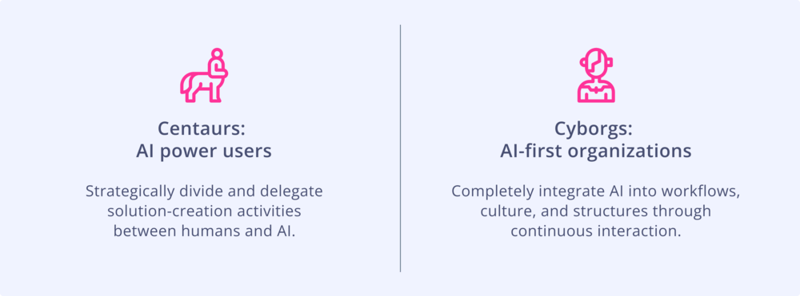
Each company is unique, of course, and which approach they choose will depend on several factors. However, across the board, the study found that the employees using AI completed more tasks faster and with higher quality compared to those without access to AI.
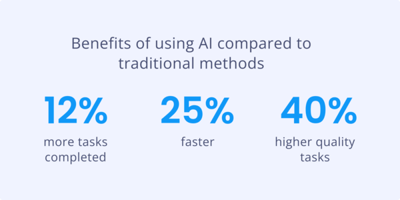
We believe that future leaders in innovation will resemble cyborgs, seamlessly intertwining collective creativity with AI at the very frontier of capabilities.
Fully embedded AI is one of the key attributes shared by future-built companies that excel across financial and nonfinancial measures.
In moving toward this AI-first approach, there are several implications to consider to ensure a smooth transition and maximum return on innovation.
Talent
The invention of spreadsheet software did not make accountants obsolete. Calculations became instant, and accountants became more valuable. Similarly, machine intelligence is not replacing the human ingenuity and strategic thinking needed in innovation but rather multiplying it to unlock new potential.
Generative AI’s greatest potential is not replacing humans; it is to assist humans in their efforts to create hitherto unimaginable solutions.
The need for interdisciplinary innovation teams and managers isn’t going anywhere. In fact, recent research shows that jacks-of-all-trades innovators are more likely than specialized researchers to integrate new knowledge to create impactful innovations.
Companies must also cultivate a diverse skill set that includes AI literacy, which means having a basic understanding of how AI works, its capabilities, and its limitations. This knowledge will enable them to interpret and evaluate AI-generated insights and ideas appropriately and identify opportunities for further integration.
Structure
Traditional and rigid hierarchies tend to be slow to arrive at decisions and implement new ideas. With AI-driven innovation, more flexible and decentralized organizational structures will thrive. Flatter structures are more agile and responsive, deftly adapting to market shifts and technological advancements.
Machine intelligence capabilities mitigate many of the traditional barriers to participation in innovation that employees often face. With AI-powered tools automating manual and tedious processes, spotting connections, and channeling creativity, innovation becomes significantly more accessible at all organizational levels.
While this boost in participation may mean a greater breadth of innovation intelligence, prioritizing what intelligence to act upon should remain the job of a dedicated team within the organization. Here is where a chief innovation officer is essential to manage all stakeholders, define the strategic direction, and nurture a culture of innovation.
Speed
Speed in innovation is essential. You need to make decisions quickly, act before your competition, and remain agile to continuously adapt to changing market conditions. Augmenting innovation processes with machine intelligence speeds up knowledge extraction and data analysis, automates manual tasks, and allows for the rapid identification and resolution of complex problems.
Speed is indeed one of AI’s biggest benefits. But this accelerated pace must be balanced with careful consideration and due diligence. Without an adequate innovation governance framework in place, fast-moving organizations are at a higher risk of releasing products that overlook quality assurance or regulatory compliance. They may overemphasize short-term gains, losing sight of long-term Horizon 3 investments. Or meet resistance from employees as their organizational culture lags behind the pace of change.
In innovation, you want an engine capable of maximum speeds. But you also need your steering, brakes, and navigation to be in top form to ensure you get to your destination. Not only quickly but also safely, having maneuvered all the potholes, hairpins, and rerouting along the way. That’s why it’s essential to match the speed of machine intelligence capabilities with the strategic leadership only a human can provide.
Scale
In essence, speed and scalability are two sides of the same coin in innovation. If speed enables organizations to innovate quickly and respond to immediate needs, scalability ensures that these innovations can be sustained, expanded, and adapted over the long term. And similarly, machine intelligence’s ability to make sense of complex information and automate processes makes it a powerful enabler for scaling innovation.
Scaling new ideas and launching innovations at the right time, at the right magnitude, is where much of the value in innovation lies. In an analysis of US venture capital (VC) data, McKinsey & Company found that two-thirds of value creation occurs by scaling new products and services. This means that it’s not enough to have a great idea; you need to turn these ideas into practical solutions that reach large audiences, address broad challenges, or capture sustained value over time.
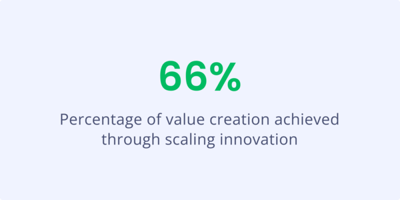
Scaling innovation also involves more than just expanding innovative ideas or products. It's essential to establish effective innovation management processes and structures that can handle the increased complexity of more inputs (signals and drivers of change), more outputs (opportunities, ideas, projects), and more participants (employees, partners, external collaborators).
The way forward: augmented intelligence in innovation
How can you successfully transition from the tradition ways of innovating to AI-driven innovation?
We’re experiencing a watershed moment for augmented intelligence. More than three-quarters of executives are investing in automating systems in their organizations—the majority of which is going toward future endeavors. And nearly a third of top innovators are already deploying GenAI at scale in their innovation and R&D functions.
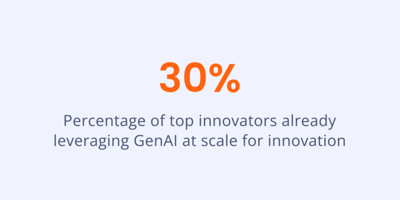
Indeed, there are already many successful examples of AI-driven innovation—from predictive analysis and faster prototyping to the groundbreaking applications of GenAI in ideation and creative fields like content, design, and video. Companies leading this shift in AI-driven innovation are seeing their ideas funnel grow by a factor of five and are twice as selective in incubation—making them better equipped to rigorously prioritize high-value innovation.
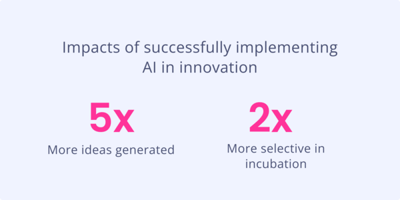
The spark of innovation still lies in human ingenuity, collaboration, and diverse perspectives. Advances in the way we make sense of data, perform complex tasks, and even generate ideas do not diminish the importance of human intellect in innovation. Rather, augmenting your team’s capabilities with machine intelligence is about streamlining efforts, amplifying collective creativity, and ensuring that time and resources are spent optimally to maximize your return on innovation.
ITONICS is innovating the way organizations innovate. We’re on a mission to empower everyone to innovate—systematically, successfully, and continuously. That’s why we’re infusing machine intelligence capabilities throughout the Innovation OS. We’re shaping the future of innovation, so you can innovate for the future.


